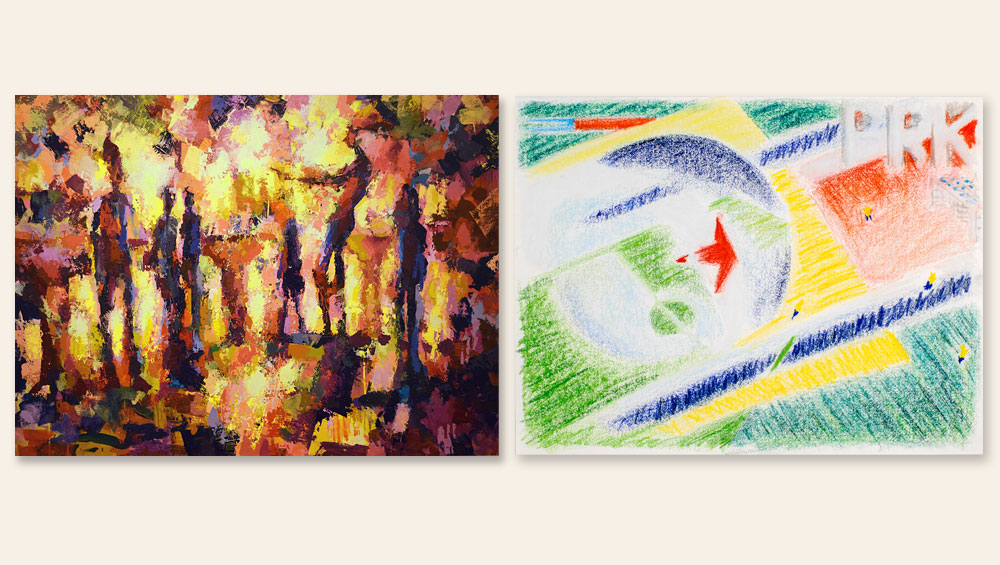
Figureworks Gallery, Brooklyn
8 June – 29 July 2018
by NATASHA KURCHANOVA
Figureworks, a gallery in the Willamsburg section of Brooklyn in New York city, specialises in figurative art. Founded in 2000, it exhibits works – mostly paintings and sculpture – by local artists. The current exhibition features two painters, Shelley Himmelstein (b1957, Broomall, Pennsylvania) and Michael Sorgatz (b1968, Chicago), who emphasise various ways of working with colour. While in her FIFA World Cup soccerscapes Himmelstein captures the movement and energy of the players and the excitement of fans surrounding this competitive event, in his mesmerising dreamscapes Sorgatz plays with figures and abstraction in a completely fantasised way. The two artists are very different in how they approach and reflect the world: Himmelstein’s sketches and paintings are based on watching a real event – a football match – which she then abstracts by working quickly with materials that allow her to convey an uplifting feeling; Sorgatz invents his entrancing abstractions and introduces figures into them to have a recognisable point of reference. The exhibition, then, is a perfect example of a wide-ranging approach to figuration versus abstraction that artists use to create a way to communicate with the viewer.
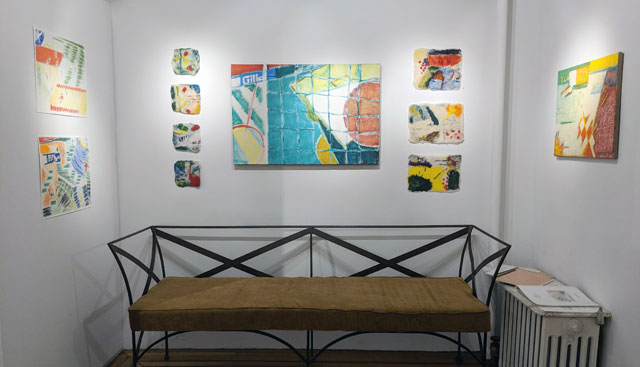
Shelley Himmelstein: Soccerscapes – FIFA World Cup Series. Installation view. Photograph courtesy of Figureworks Gallery.
I talked with the artists and with the gallery owner, Randall Harris, who curated the exhibition.
Randall Harris: I am the director of Figureworks Gallery, which I opened in 2000. It is called Figureworks because all the artists in the gallery work with the human figure in one way or another. I felt there was a need at the time to get figurative work exposed. Over the past 18 years, I have built up a stable of figure-based artists and continue to introduce new artists to the gallery. At this time, I have a show with two artists. Michael Sorgatz is one of my established gallery artists – this is his third solo show. Along with this exhibition, I introduced Shelley Himmelstein. Shelley is typically not a figure-based artist. I have known her for a long time, but we have not worked together until now. She proposed this World Cup series, which she has done every four years for the past 20 years now. I thought it was a fun idea, considering that it was coming up again and that this was the time to do it, to get the attention and to support the series. I decided on exhibiting her series at the last minute, whereas Michael’s show has been planned for a year. Initially, I just wanted to do an event with Shelley and invite her to show some of the works and do a live performance during the World Cup finals. But as I looked at the works and we thought through the preparation of this event, I felt this work should be up for the whole time. So, I basically mounted two shows: Michael kept his solo show and Shelley has her solo show. I enjoyed going through her work and choosing the pieces about the World Cup that she’s done at different points over the course of the past 20 years.
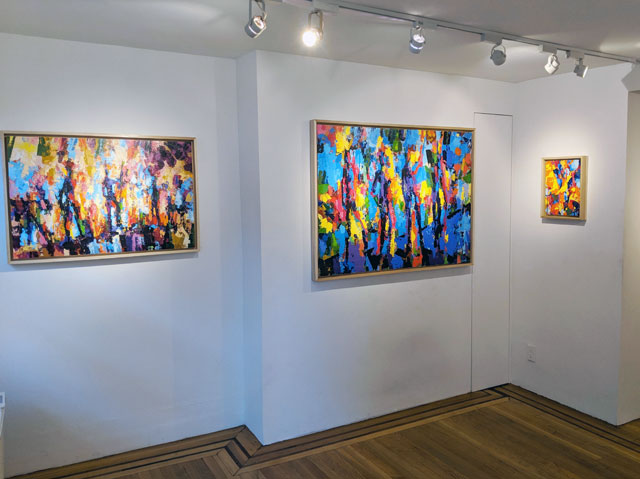
Michael Sorgatz: Kaleidoscope Dreams. Installation view. Photograph courtesy of Figureworks Gallery.
Natasha Kurchanova: Do you often do two shows at the same time and in the same space?
RH: No. Usually, I mount solo shows or, occasionally, thematic group shows. I have done two-person shows if I feel that they work well together. This was a little different because it was not about the two of them working well together; it was about the event I mentioned and Michael’s work. Now that Shelley’s work is up, I see that they work well together. It’s interesting because both of them make very abstracted works and, of course, in this series, Shelley’s have tiny players in them. Michael’s always supports hidden figures in abstracted environments. Both use bright palettes, so it’s a perfect summer show with all the colour in it. I am loving it.
NK: Do you only exhibit artists from New York, or can they be from other places?
RH: They do not have to be from New York, but, yes, I try to keep it local. The majority of my artists are from New York and Brooklyn in particular. People come to Williamsburg to find local work. When I opened, there were a lot of artists around here, so it was easy to make a connection with them.
NK: You have been here for a while. Before, your gallery was upstairs, as I remember.
RH: I was on the second floor for 17 years; I moved down here, to the first floor, a year and a half ago. It is a row [terraced] house; there was a tenant on this floor who moved out, so the timing was right and I decided to make this transition.
NK: Did you notice any change in business when you moved down to the first floor?
RH: Yes. Williamsburg peaked as an art gallery scene a few years ago and people came here specifically for the art scene. At one point, there were more than 40 galleries here. We formed an association; we were really tight. Then, as in many of these stories, developers came in, prices went up, and the galleries could not sustain it. A number of galleries are still going strong, but making the transition downstairs has been helpful, because it put me on ground level and it makes me more accessible and visible to tourists, window shopping and new residents moving into the area.
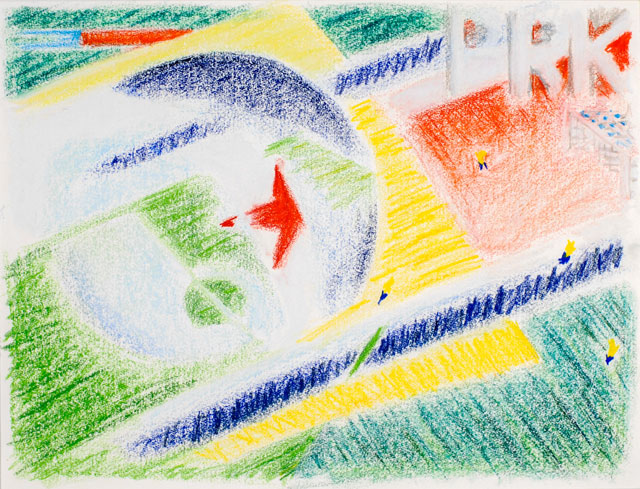
Shelley Himmelstein. World Cup 2010, Brazil vs Korea. Prismacolor, 15 x 20 in. Photograph courtesy of Figureworks Gallery.
Shelley Himmelstein: My work based on the World Cup spans a lot of time. I began making soccer compositions in 1994 because I became interested in the inspiring movement and visuals of the matches. These works are unique for me, offering the opportunity to convey a charge of human energy that does not appear in my customary landscapes. Little “blips” representing players even appear. In the earliest works, I drew with Prismacolor – which is not a pastel but more like a pencil stick – and made little sketches of games I’d catch on TV. Finally, after several World Cups, in 2006, I committed to do a series of every match, large scale, in Prismacolor. In between World Cups, I have occasionally done oil paintings and feltworks based on these sketches, some of which are included in this show. In 2014, given my increasing involvement with watercolour, I decided to do the series in watercolour, because its fluidity matches the energy of the games.
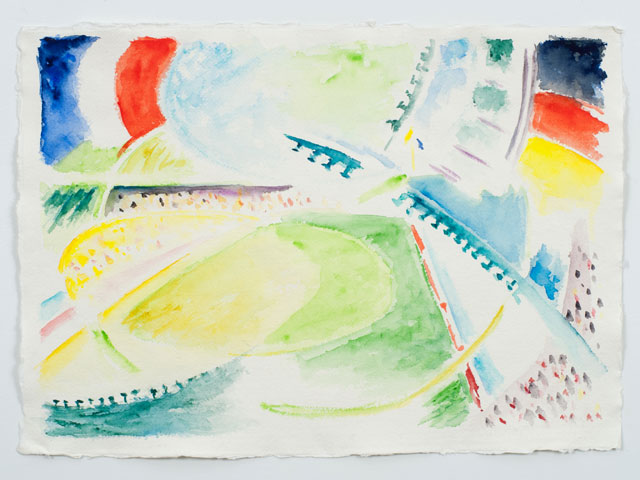
Shelley Himmelstein. World Cup 2014, France vs Germany. Watercolour, 12 x 18 in. Photograph courtesy of Figureworks Gallery.
NK: Was that because watercolour responds quickly to the changes you see in the field?
SH: Yes, it responds quickly and encourages me to plunge into the moment and work intuitively, responding to the actions and surprises both in the match and the application of the watercolour. There is so much visual information taking place every second – from the players’ actions to the views of the field, advertisements and stadium – as well as hearing the excited broadcast commentary. All of that goes into the work. I allow myself to be as spontaneous as possible and avoid setting rules about what and how to depict each match. I mix techniques (wet on wet, dry brush, layering pigments) within a composition and change approach from composition to composition, letting watercolour’s fluid nature “play” freely in the process. Watercolour can be very unforgiving; if you make a mistake, it’s not going away. However, mistakes in this series are merely missteps followed by the next action and then another until they become a contributing part of the visual testimony.
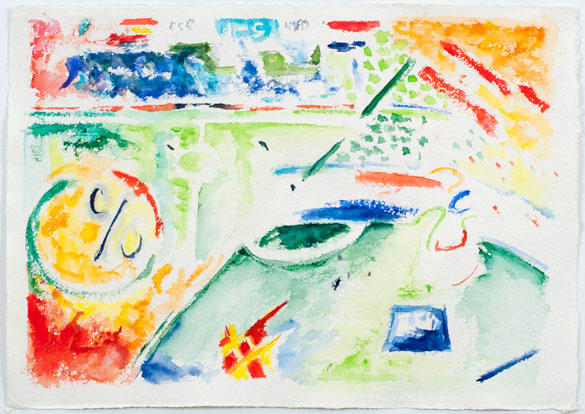
Shelley Himmelstein. World Cup 2014, Spain vs Netherlands. Watercolour, 12 x 18 cm. Photograph courtesy of Figureworks Gallery.
NK: So, the fact that the game is circumscribed in space and time helps you with the work?
SH: Yes, it does help because, whereas I usually allow work time to be as long as a painting needs, this framework forces me to trust immediate judgment and respond to each moment as it happens. This makes the experience very exciting. I pace myself to bring the work to a conclusion within the approximate two hours of a match. The goal is not necessarily perfectly “finished” works, rather it is to attain an adequate visual summary by the close of a match, then leave it to go on to the next. For World Cup years when I do every match, the 56 works conceptually create a whole. The entire world is involved in the World Cup and as one of many people who do not follow soccer but avidly follow the World Cup, these works allow me to contribute to the shared enthusiasm that branches out across cultures and interests.
NK: It looks as if this exhibition features several periods of your engagement in capturing the World Cup?
SH: Yes. I began drawing World Cup matches in 1994. The painting you see behind us is one of the first done from the sketches. Then, there are feltworks from 2007 based on the 2006 matches, and the “live” compositions from 2010 and 2014.
NK: So, you have many more, since you have been doing them for more than 20 years.
SH: Yes. For the World Cups from 2006, 2010 and 2014, I have done a complete set of drawings for every match. Before that, I captured only selected games that I could watch. The complete sets track the excitement built up as matches progress from the group phase to the knockout phase and finals.
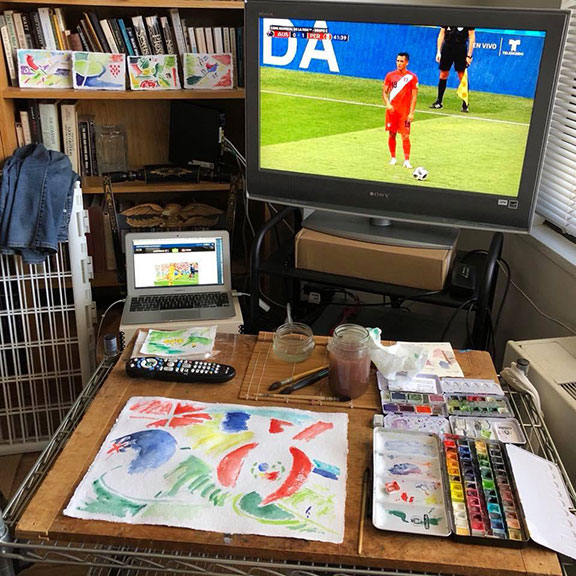
Shelley Himmelstein. Desktop with TV. Photograph courtesy of Figureworks Gallery.
NK: And these soccerscapes exist in different media – oil, watercolour, Prismacolor sticks …
SH: Yes. Prismacolor sketches and watercolours used in the “series” are executed during the live transmissions of the matches. And then, afterwards I may work on compositions in oil paint or felt. Usually, when basing these oils and feltworks on one of the existing sketches, I change things around so that they initiate a new exploration of the visual themes.
NK: Do you always watch the matches on TV or do you sometimes go to the games?
SH: So far, I have always watched them on TV. I am curious if I will ever end up in a soccer stadium. I imagine being there would feel very different, and I would probably like it. However, when a neighbour encouraged me to go to a bar to watch and do my drawings there, I doubted I could deal with hardcore soccer fans – they are so extroverted and so excitable. Working from a more private setting allows me a distance to process the raw energy and excitement, which may be needed for an introvert, such as myself.
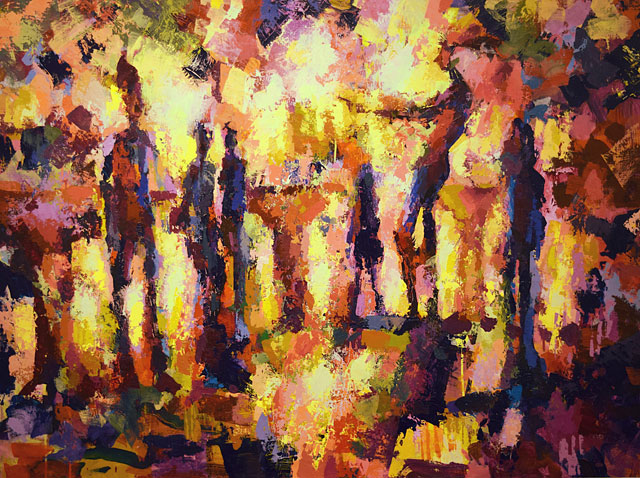
Michael Sorgatz. Kaleidoscope Dreams, 2017. Acrylic on board, 36 x 48 in. Photograph courtesy of Figureworks Gallery.
Michael Sorgatz: The show represents a year-and-a-half of work. It’s more about covering a span of time. There is no centralised theme, although I typically work with a figure and abstraction, trying to figure out how to connect these two extremes. The work itself is very open-ended. I like to leave it open for an interpretation by the viewers. They should be able to bring their own stories to it rather than to have it clearly defined.
NK: What is the process of your work? You start with figures and then you abstract them?
MS: Sometimes I begin just with a seed of an idea. Perhaps, it’s just a colour that I want to put down on the canvas, or a group of figures, or maybe even a gesture. From there, I like the work to develop on its own. It’s more interesting for me to work this way, instead of have it all planned out in advance. In some of the works, such as this one titled Splash, there is a completely different painting underneath. I was very frustrated with the direction in which it was moving and decided to cover it up with large swatches of colour, which brought the piece back to life for me. I do not have a formula, a way I typically approach it. My work is mostly improvisational. I like a spontaneous approach.
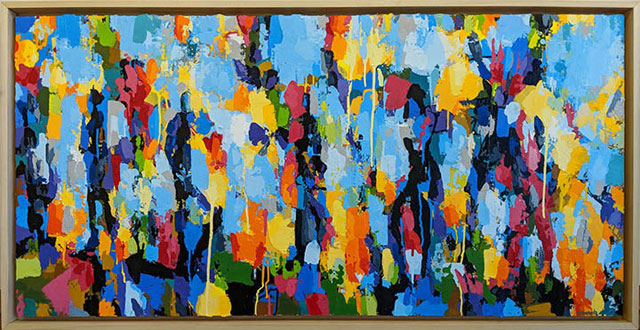
Sorgatz Summer Dragon, 2018. Acrylic on board, 24 x 48 in. Photograph courtesy of Figureworks Gallery.
NK: But figuration has to be part of it somehow? Some elements of the image have to be recognisable?
MS: Yes. I like working with figures, because pure abstraction is too ambiguous for me. I like to have some recognisable elements for the eye to latch on to, even though I am happy leaving this relationship between the figure and abstraction somewhat ambiguous.
NK: How long have you been with this gallery?
MS: I think it’s been about eight years since I have been here. I am based here in Brooklyn, but I am from California originally. I came to the city at around the same time that Figureworks started.
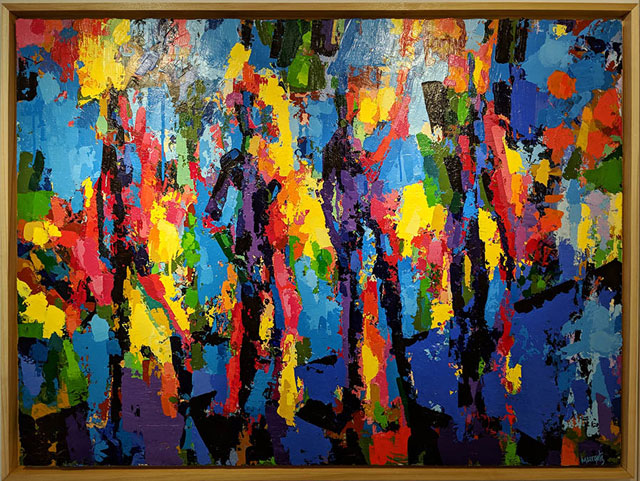
Michael Sorgatz. Yo Taxi, 2018. Acrylic on board, 36 x 48 in. Photograph courtesy of Figureworks Gallery.
NK: How has your work evolved since you have been showing in this gallery?
MS: Since I have been showing here, my general theme has been abstracting the figure. My earlier work is actually photo-based. It was much more geometric. Over the years, I have abandoned the photograph and have been painting invented figures. It’s become looser and more organic. I use photography more for reference; I mostly paint, although I do a little bit of printmaking. I work usually in this small- to medium-scale traditional painting format – 3ft x 4ft is the most common format for me. The largest piece I’ve done recently was 4ft x 6ft. Most of my works are painted on board.
NK: What inspires your work?
MS: I steal from as many people as I can! When I see something, I absorb it, and the way it comes out is different from the source that inspired me. It’s all a fair game. I am looking forward to seeing the Giacometti show at the Guggenheim. I really enjoy his work. His sculpture relates more to solitary figures than I do, but I am inspired by him nonetheless. I am open to all sorts of different work. The Bay Area figurative movement had an early influence on me because I grew up on the west coast. I was just at the Morgan Library, which has the Wayne Thiebaud drawing show. I love his work from way back. A lot of my attraction to painting comes from enjoying my work with the materials of art as opposed to art’s conceptual aspect. I like to get my hands dirty.